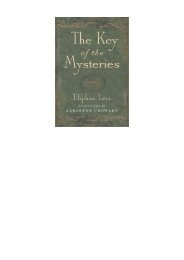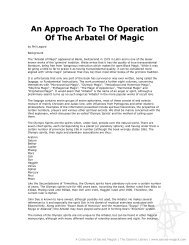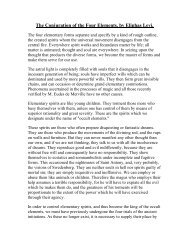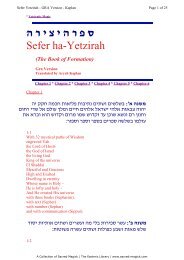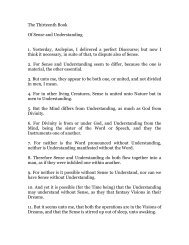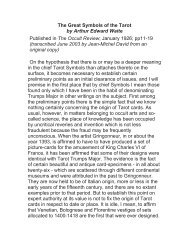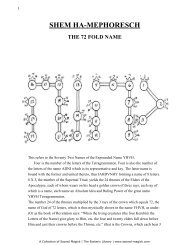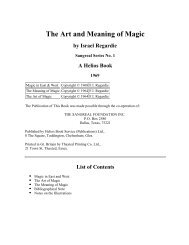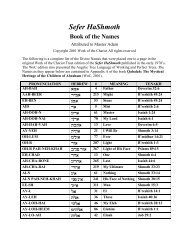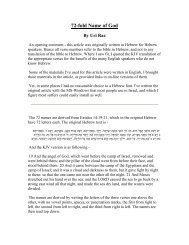Goetia - Holy Order of the Golden Dawn Canada
Goetia - Holy Order of the Golden Dawn Canada
Goetia - Holy Order of the Golden Dawn Canada
Create successful ePaper yourself
Turn your PDF publications into a flip-book with our unique Google optimized e-Paper software.
with <strong>the</strong> names on <strong>the</strong> circle and triangle <strong>of</strong> <strong>the</strong> Goëtia (it appears in this edition as “Explanation<br />
<strong>of</strong> Certain Names &c.”), some highly corrupt Hebrew names, a short and garbled conjuration<br />
including said names (probably also connected with <strong>the</strong> Goëtia as it mentions <strong>the</strong> brazen vessel),<br />
and finally, <strong>the</strong> “Mighty Oration”, a lengthy curse targetted at anyone who steals <strong>the</strong> MS. codex.<br />
The Ars Nova should not be confused with <strong>the</strong> Ars Notoria (Notary Art) attributed variously<br />
to Solomon and Apollonius <strong>of</strong> Tyanæa, which latter ra<strong>the</strong>r appears to be a medieval magical<br />
derivative <strong>of</strong> classical art <strong>of</strong> memory, based around <strong>the</strong> contemplation <strong>of</strong> images or notæ while<br />
repeating prayers. The Ars Notoria was condemned by Aquinas (cited in Yates, Art <strong>of</strong> Memory)<br />
and various Renaissance writers such as Erasmus and Agrippa (in De vanitate &c.); Robert<br />
Turner produced an English translation which was made less than useful by <strong>the</strong> omission <strong>of</strong> <strong>the</strong><br />
figures: this translation was incorporated into some later MSS. and printed editions <strong>of</strong> <strong>the</strong><br />
Lemegeton. Some figures from medieval MSS. <strong>of</strong> <strong>the</strong> Ars Notoria are printed in an article in a<br />
volume called Conjuring Sprits: Texts and Traditions <strong>of</strong> Medieval Ritual Magic, edited by Clare<br />
Fanger (Stroud: Sutton).<br />
A few complete editions <strong>of</strong> <strong>the</strong> Lesser Key have been printed since <strong>the</strong> Ma<strong>the</strong>rs-Crowley<br />
edition <strong>of</strong> <strong>the</strong> Goëtia was issued. One, edited by Nelson White, appears to have been prepared<br />
from ei<strong>the</strong>r Sloane 2731, or a codex <strong>of</strong> similar content, and omits <strong>the</strong> Ars Nova on <strong>the</strong> grounds<br />
that <strong>the</strong> editor considered it worthless. A more recent and thorough edition, edited by Joseph<br />
Petersen (Red Wheel / Weiser, 2002) was prepared from various codices and includes <strong>the</strong> Ars<br />
Notoria (mainly following Turner’s translation).<br />
Crowley’s threatened “History <strong>of</strong> <strong>the</strong> <strong>Order</strong> <strong>of</strong> <strong>the</strong> <strong>Golden</strong> <strong>Dawn</strong>” did not manifest under that<br />
title; see instead <strong>the</strong> instalments <strong>of</strong> The Temple <strong>of</strong> Solomon <strong>the</strong> King by J. F. C. Fuller (based on<br />
Crowley’s notebooks) published in Equinox vol. I nos. 2, 3 and 4, as well as The Magicians <strong>of</strong> <strong>the</strong><br />
<strong>Golden</strong> <strong>Dawn</strong> by Ellic Howe and Ritual Magic in England by Francis X. King.<br />
Shemhamphorash.<br />
The Shem ha-Mephorash (crmph \c) is <strong>the</strong> “Divided Name” or “Name <strong>of</strong> Extension” derived<br />
by Kabbalists from three consecutive verses in <strong>the</strong> Book <strong>of</strong> Exodus, each <strong>of</strong> which has 72 letters<br />
in <strong>the</strong> original Hebrew. By writings <strong>the</strong>se verses out in rows, <strong>the</strong> first and third right to left as<br />
usual, <strong>the</strong> second left to right, and reading down <strong>the</strong> columns, 72 three-letter names are obtained.<br />
On <strong>the</strong> basis that <strong>the</strong> first verse mentions “<strong>the</strong> angel <strong>of</strong> <strong>the</strong> Elohim”, from each three-letter group<br />
<strong>the</strong> name <strong>of</strong> an Angel is obtained by appending ei<strong>the</strong>r hy or la. The analogy with <strong>the</strong> 72 spirits <strong>of</strong><br />
<strong>the</strong> <strong>Goetia</strong> should be obvious.<br />
For eight spirits, two forms <strong>of</strong> <strong>the</strong> seal were given by Ma<strong>the</strong>rs. In most cases <strong>the</strong> variations<br />
are minor, attributable to divergence from repeated copying: any given MS. would only have had<br />
one. The exception is Buné, where at least one MS. gives two significantly different forms.<br />
Fur<strong>the</strong>r, <strong>the</strong> proportions <strong>of</strong> some <strong>of</strong> <strong>the</strong> seals have been squashed or stretched somewhat to fit <strong>the</strong>m<br />
inside <strong>the</strong> circular borders (not present in most MSS); compare <strong>the</strong> forms in this edition with those<br />
given by Waite in Book <strong>of</strong> Black Magic and <strong>of</strong> Pacts and by Hyatt and DuQuette in <strong>the</strong>ir edition <strong>of</strong><br />
<strong>the</strong> <strong>Goetia</strong>, or <strong>the</strong> forms from Sloane MS 3825 by Joseph Petersen in his electronic edition.<br />
Where Ma<strong>the</strong>rs has remarked unusual or variant readings in <strong>the</strong> description <strong>of</strong> a spirit in a<br />
footnote, I have in many instances cross-referenced to <strong>the</strong> corresponding entry in <strong>the</strong> Pseudomonarchia.<br />
Issues that cannot be dealt with in a brief footnote are discussed below.<br />
Two handwritten marginal notes by Crowley to this section which appeared in <strong>the</strong> First<br />
Impressions edition are omitted; as in one instance <strong>the</strong>re was no obvious citation point (<strong>the</strong> note<br />
read “I think he can only be invoked at this time” and appeared at <strong>the</strong> bottom <strong>of</strong> <strong>the</strong> page with <strong>the</strong><br />
descriptions <strong>of</strong> Paimon, Buer and Gusion) and <strong>the</strong> o<strong>the</strong>r one (to <strong>the</strong> description <strong>of</strong> 31, Foras) was<br />
partially illegible and I could make no sense <strong>of</strong> it (it appears to read: “Distinguish from<br />
(?)Sandow”).<br />
76




